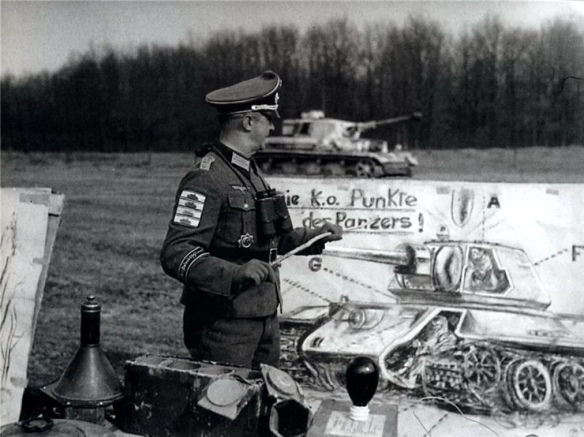
1943 Panzer-Grenadier-Division “Großdeutschland” follows a combat training tank before “Operation Zitadelle”. We are Akhtyrka, the main base of the unit, located in the northeast of Kharkov.
The Tiger tactical number B01 of th 10th company of the III Abteilung of the “Großdeutschland” Division passes in front of some divisional vehicles.
Officers from Großdeutschland Division plan their next move in July 1943. The division was part of XLVIII Panzer Corps (Otto von Knobelsdorff) of the 4th Panzer Army (Hermann Hoth) and fought on the left flank of II SS Panzer Corps throughout Operation Zitadelle.
Although the front was now vastly extended and thinly held, Manstein’s new positions offered to the German High Command the opportunity of an attack on the Soviet salient centred on Kursk. Code-named Zitadelle, the ensuing plan projected converging strikes on the northern and southern flanks of the salient to achieve a double envelopment. However, pre-warned of the German intentions by intelligence sources, General Zhukov was able to fortify the salient heavily. Both sides continued to build up their strength through the late spring and early summer and by the eve of the German attack some 2 million men and over 6,000 tanks were ready to go into action.
Grossdeutschland was formally redesignated as a Panzergrenadier division a week prior to the attack, on 23 June, and became almost identical in organisation to one of the elite SS Panzer divisions. During 1942 all the Army’s infantry regiments had been renamed grenadier regiments and in 1943 the Infanterie-Divisions (mot) became Panzer-Grenadier-Divisions. However, the term Panzergrenadier is something of a misnomer, for in fact they were not always ‘armoured’, and would be better described as ‘motorised infantry’.
Having been brought up to full strength for Zitadelle, the division began to the march to the staging area north of Tomarovka at the end of June 1943. The attack, launched on 4 July, saw the Ninth Army attack from the north and the Fourth Panzer Army from the south, across the base of the Soviet salient. GD attacked west of Strelazkoye with the 3rd and 11th Panzer Division, and initially made rapid advances. However, in the north the Ninth Army was stopped before a heavily fortified ridgeline on the 9th and the attack broke down, GD having advanced through the heavily defended Soviet lines as far as Kotschetovka.
On 12 July the Russians launched a strong counter-attack against the front north of Orel behind the Ninth Army. In the heavy fighting around Kalinovka, GD took heavy casualties, countering a series of Soviet armoured attacks in the second week of July. On the 17th, the division was relieved and transferred to Tamnoye to the south of the Kursk battlefield, by which point Hitler had been forced to concede defeat. Four days later GD moved again, by truck and rail, to the vicinity of Karachev, where it had fought the previous year, and was assigned to Army Group Centre.
Here it resisted the Russian advance from Bolkhov, until in early August a strong Russian attack in the south caused GD to be rushed south to join Army Group South at Akhtyrka on the Vorskla River, where the newly organised Tiger battalion joined the division. A fighting retreat along the central front continued through mid-August. The Russians had torn a 35-mile gap in the German line at Byelgorod, and through this they poured, heading south-west toward the Dnieper River. In their path, in positions to the east of Akhtyrka at Yankovka, Staraya Ryabina, Novaya Rabina and Yablotschnoye, Panzer-Grenadier-Division Grossdeutschland was slowly pushed back and by the 11th the men were fighting on the outskirts of Akhtyrka. At Akhtyrka, and positions to the south-east, GD battled hard, and for days with no rest, to counter the breakthrough.
Kharkov fell on 23 August, and in the last week of August the Army Group Centre front was penetrated in three places by Malinovsky’s forces and Tolbukhin’s Southern Front, threatening an envelopment of Army Group South. Against Hitler’s orders Manstein ordered Army Group South to withdraw to the Dnieper, and in so doing probably saved it.
Reassigned to the XLVIII Panzer Corps, GD was tasked in the first two weeks of September with reinforcing the weak points in the German line to the west of Kharkov and north of Poltava. As part of the general withdrawal, the division then began a skillful fighting retreat to Kremenchug, and the vital rail bridge there over the Dnieper. Fighting behind a progressively shorter line, the division had withdrawn into a pocket around the bridge by the 29th, and then began a general withdrawal over the river (among the last German troops to do so).